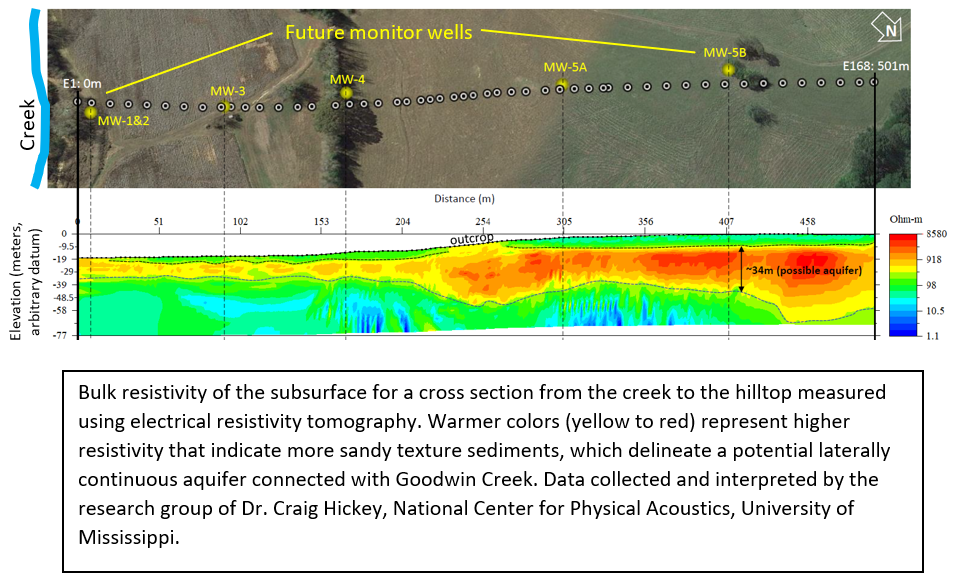| Andrew O'Reilly Additional Information |

|
Education:
BCE, Civil Engineering, 1991, Auburn University, Auburn, AL
MCE, Civil Engineering (Hydraulics/Hydrology), 1993, Auburn University, Auburn, AL
PhD, Civil Engineering (Water Resources), 2012, University of Central Florida, Orlando, FL
Research Interests:
- Vadose-zone and groundwater hydrology
- Groundwater modeling
- Contaminant transport and fate
- Green infrastructure
- Managed aquifer recharge
- Integrated water resources management
Selected publications:
Hobart, J.L., O’Reilly, A.M., and Gifford, J.N., 2022. Physical, Chemical, and Mineralogical Controls on Retardation of Anatoxin-a Migration by Sorption to Natural Soils with Implications for Groundwater Protection. Water 14: 2869. https://doi.org/10.3390/w14182869
O’Reilly, A.M., Holt, R.M., Davidson, G.R., Patton, A., and Rigby, J.R., 2020. A dynamic water-balance/nonlinear-reservoir model of a perched phreatic aquifer–river system with hydrogeologic threshold effects: Water Resources Research 56(6): e2019WR025382. https://doi.org/10.1029/2019WR025382
Gratzer, M.C., Davidson, G.R., O’Reilly, A.M., and Rigby, J.R., 2020, Groundwater recharge from an oxbow lake-wetland system in the Lower Mississippi River Valley: Hydrological Processes 34: 1359–1370. https://doi.org/10.1002/hyp.13680
Bellino, J.C., Kuniansky, E.L., O’Reilly, A.M., and Dixon, J.F., 2018, Hydrogeologic setting, conceptual groundwater flow system, and hydrologic conditions 1995–2010 in Florida and parts of Georgia, Alabama, and South Carolina: U.S. Geological Survey Scientific Investigations Report 2018–5030, 103 p. https://doi.org/10.3133/sir20185030
O’Reilly, A.M., Wanielista, M.P., Chang, N.B., Xuan, Zhemin, and Harris, W.G., 2012. Nutrient removal using biosorption activated media: Preliminary biogeochemical assessment of an innovative stormwater infiltration basin: Science of the Total Environment 432: 227–242. https://doi.org/10.1016/j.scitotenv.2012.05.083
O’Reilly, A.M., Wanielista, M.P., Loftin, K.A., and Chang, N.B., 2011. Laboratory simulated transport of microcystin-LR and cylindrospermopsin in groundwater under the influence of stormwater ponds: implications for harvesting of infiltrated stormwater. In: Schirmer, M., Hoehn, E., and Vogt, T. (eds.), GQ10: Groundwater Quality Management in a Rapidly Changing World, Proceedings of the 7th International Groundwater Quality Conference, Zurich, Switzerland, June 13-18, 2010. IAHS Publ. 342. IAHS Press, Oxfordshire, UK., p. 107–111. https://iahs.info/uploads/dms/15347.32-107-111-342-76-MO-26_IAHS.pdf
Selected research projects and activities:
Full-scale field studies of managed aquifer recharge technologies. Development of technologies for managed aquifer recharge that advance the sustainability of groundwater-irrigated agroecosystems. Research entails pilot-scale field testing of managed aquifer recharge technologies, including riverbank filtration, aquifer recharge wells, and vadose-zone recharge wells. Findings inform stakeholder decision-making regarding feasibility and effectiveness of implementation of selected MAR technologies. Below is an aerial view showing the site of the aquifer recharge wells for the Groundwater Transfer and Injection Pilot project in the Delta region of Mississippi.
Hillslope hydrologic processes in a riparian pasture/row-crop setting. Measurement and computer simulation of processes affecting infiltration, runoff, erosion, evapotranspiration, interflow, and recharge that control field-scale aquifer recharge, erosion, and groundwater-surface water interactions along a transect covering a hillside pasture adjoining a flat row-crop field adjacent to a creek. Findings inform assessments of conservation practices that can change the partitioning of rainfall into runoff, evapotranspiration, and infiltration, such as contour grading of berms/swales to reduce erosion and increase infiltration and aquifer recharge.

Selected software:
WBNLR: Dynamic Water-Balance/Nonlinear-Reservoir GW-SW interaction model. Computer program (Fortran source code and executable) and four example models. A lumped-parameter of a perched phreatic aquifer–river system model incorporating threshold effects. Four conceptualizations of the system were modeled, each of which simulates a perched aquifer as a dynamical system that receives recharge from the riverbank and loses water to an underlying regional aquifer, using combinations of zero, one, or two thresholds representing layered heterogeneity in riverbank and/or aquifer lithology. Based upon fundamental mass-conservation concepts, the simple dynamic water-balance/nonlinear-reservoir model has broad applicability to many hydrogeologic settings. http://www.hydroshare.org/resource/7bd7b3f4c91741b9bf22bfff717ec286
WBTF: Water-balance/transfer-function (WBTF) aquifer recharge model for simulating transient groundwater recharge in deep water-table settings. Computer program (Fortran source code and executable) and one example problem. The lumped-parameter model represents a one-dimensional column from the top of the vegetative canopy to the water table and consists of two components: (1) a water-balance module that simulates the water storage capacity of the vegetative canopy and root zone; and (2) a transfer-function module that simulates the travel time of water as it percolates from the bottom of the root zone to the water table. Data requirements include two time series for the period of interest—precipitation (or precipitation minus surface runoff, if surface runoff is not negligible) and evapotranspiration—and values for five parameters that represent water storage capacity or soil-drainage characteristics. https://pubs.usgs.gov/sir/2004/5195/ancillary_data/

